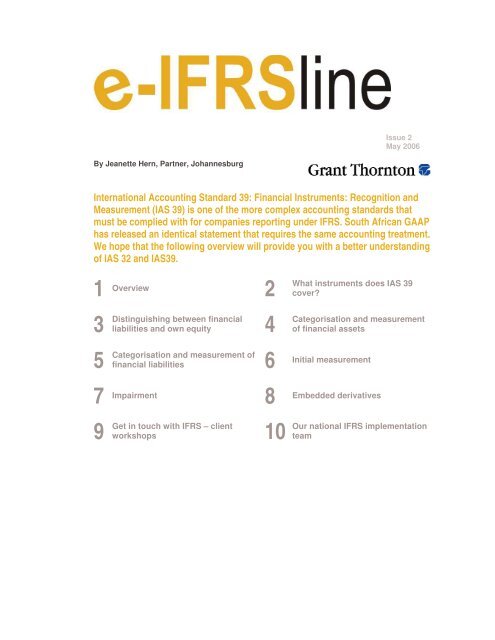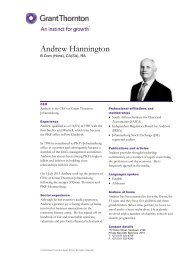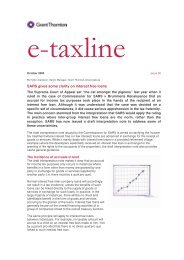e-IFRSline May 06 - IAS 39: Financial Instruments - Grant Thornton
e-IFRSline May 06 - IAS 39: Financial Instruments - Grant Thornton
e-IFRSline May 06 - IAS 39: Financial Instruments - Grant Thornton
- No tags were found...
You also want an ePaper? Increase the reach of your titles
YUMPU automatically turns print PDFs into web optimized ePapers that Google loves.
Issue 2<strong>May</strong> 20<strong>06</strong>By Jeanette Hern, Partner, JohannesburgInternational Accounting Standard <strong>39</strong>: <strong>Financial</strong> <strong>Instruments</strong>: Recognition andMeasurement (<strong>IAS</strong> <strong>39</strong>) is one of the more complex accounting standards thatmust be complied with for companies reporting under IFRS. South African GAAPhas released an identical statement that requires the same accounting treatment.We hope that the following overview will provide you with a better understandingof <strong>IAS</strong> 32 and <strong>IAS</strong><strong>39</strong>.1 Overview 235Distinguishing between financialliabilities and own equity 4Categorisation and measurement offinancial liabilities 6What instruments does <strong>IAS</strong> <strong>39</strong>cover?Categorisation and measurementof financial assetsInitial measurement7 8 Impairment Embedded derivatives“Health related statement”Get in touch with IFRS – client9 workshops10“Health related statement”Our national IFRS implementationteam
1 OverviewMany companies have ignored <strong>IAS</strong> <strong>39</strong> (AC133) under the misconception that the standard onlyapplies to financial institutions such as banks and insurance companies. This is incorrect as thedefinition of a financial instrument includes balance sheet items such as investments in equity sharesof another entity, cash, loans and receivables, trade debtors, trade creditors and derivatives, such asshare or currency options, currency forward contracts, commodity forward contracts or interest ratesswaps.2 What instruments does <strong>IAS</strong> <strong>39</strong> cover?<strong>IAS</strong> <strong>39</strong> applies to the recognition and measurement of financial instruments, except for certainspecifically excluded items. The basic definitions are set out in <strong>IAS</strong> 32 and apply also to <strong>IAS</strong> <strong>39</strong>.What are financial instruments?A financial instrument is any contract that gives rise to a financial asset of one entity and a financialliability or equity instrument of another. This definition therefore contains three key terms.A "financial asset" is any asset that is:• cash• an equity instrument of another entity• a non-derivative contract to receive a variable number of the entity's own equity instruments• a contractual right to receive cash or another financial asset or to exchange financial assets orfinancial liabilities on potentially favourable terms• a certain type of complex derivative as specified in <strong>IAS</strong> 32.A "financial liability" is any liability that is:• a contractual obligation to deliver cash or another financial asset to another entity, or toexchange financial assets or financial liabilities with another entity under conditions that arepotentially unfavourable to the entity• a non-derivative contract to deliver a variable number of the entity's own equity instruments, or• certain types of derivative obligation to deliver the entity's own equity instruments.An "equity instrument" is any contract that evidences a residual interest in the assets of an entity afterdeducting all of its liabilities, e.g. ordinary shares or most share options.A "derivative" is a financial instrument whose value changes in response to the change in anunderlying variable (e.g. interest rate, exchange rate, price index). A derivative requires relativelylittle initial investment and is settled at a future date.<strong>Financial</strong> assets and liabilities include, for example, investments in equity shares of another entity,cash, loans and receivables, trade debtors, trade creditors and derivatives, such as share or currencyoptions, currency forward contracts, commodity forward contracts or interest rates swaps.What instruments are excluded from <strong>IAS</strong> <strong>39</strong>'s scope?The main financial instruments excluded from <strong>IAS</strong> <strong>39</strong> are:• investments in subsidiaries, associates and joint ventures (as dealt with by <strong>IAS</strong>s 27, 28 and 31)although derivatives relating to these investments remain within the scope of <strong>IAS</strong> <strong>39</strong>• an issuer's own equity instruments, as defined by <strong>IAS</strong> 32• leases (accounted for under <strong>IAS</strong> 17) although <strong>IAS</strong> <strong>39</strong> applies to derecognition, impairment oflease receivables and embedded derivatives, e.g. prepayment options within leases• employee benefit plans (covered by <strong>IAS</strong> 19)• share-based payments (dealt with under IFRS 2) unless they fall within the criteria noted belowfor certain contracts to buy or sell non-financial items• obligations under insurance contracts• contingent consideration in business acquisitions in respect of the acquirer (dealt with by IFRS 3)• loan commitments (although <strong>IAS</strong> <strong>39</strong> includes rules for provisions in respect of commitments toissue loans at less than market value). This exclusion does not apply where the commitment canbe settled net (such as where loan assets are sold shortly after origination) or where thecompany designates commitments as at fair value through profit or loss.
3 Distinguishing between financial liabilities and own equity<strong>IAS</strong> 32 addresses the distinction between a financial liability and an entity's own equity. <strong>IAS</strong> <strong>39</strong> doesnot address measurement of an entity's own equity instruments. Where there are obligations todeliver the entity's own equity instruments, detailed consultation of <strong>IAS</strong> 32 is required to determinewhether that item is a financial liability (and so within <strong>IAS</strong> <strong>39</strong>'s scope) or an equity instrument.Examples of classifications as liabilities or equity include:• an entity's own ordinary shares with no redemption rights and no fixed dividends are equity• preference shares with fixed dividends or redemption rights are financial liabilities (and so within<strong>IAS</strong> <strong>39</strong>) to the extent that they are comparable to a similar debt instrument• convertible bonds issued that convert (at holder's option) into a fixed number of shares arecompound financial instruments and are split into a liability component for the bond and an equitycomponent for the conversion option• an option issued to a third party to allow it to purchase a fixed amount of the entity's own sharesfor a fixed amount of cash is an equity instrument.Note that the distinction between equity and liabilities for IFRS purposes may not be the same as forlegal purposes. A classic example of this situation is the preference share. Preference shares thatare redeemable at a specified date for cash are classified as equity for legal purposes, howeverbecause the is a contract (term of the preference shares stated in the articles of association)specifying that the company has the obligation to redeem those shares at a future date for cash is aliability under IFRS principles.4 Categorisation and measurement of financial assetsEach financial asset should be allocated to one of the following four categories identified in <strong>IAS</strong> <strong>39</strong>:• at fair value through profit or loss• held to maturity• loans and receivables• available for sale.<strong>Financial</strong> assets at fair value through profit or loss<strong>Financial</strong> assets in this category are carried at fair value, with fair value changes going through theprofit and loss account. This category covers:• financial assets held for trading − these include all derivatives which are financial assets (apartfrom those designated as hedging instruments) and other financial assets held principally for salein the short term• financial assets designated as being at fair value through profit or loss. An entity may opt todesignate a financial asset into this category but this must be on initial recognition and may notbe changed subsequently. The <strong>IAS</strong> <strong>39</strong> "fair value option" amendment limits such designation tocases where it eliminates or reduces an accounting mismatch, it relates to a group of assetswhich are managed and their performance evaluated on a fair value basis, or where theinstrument is a hybrid contract containing an embedded derivative.Held-to-maturity investmentsThese are assets that have fixed or determinable payments that the entity has a positive intentionand ability to hold to maturity. They are measured at amortised cost. <strong>Financial</strong> assets may not beincluded in this category where a previous asset was so categorised in the last two years but wassold before its redemption date."Amortised cost" means the amount recognised initially less principal repayments plus or minuscumulative amortisation using the effective interest method of the difference between initial amountand maturity amount. Reductions for impairment or uncollectibility are made where necessary.Loans and receivablesThese are non-derivative financial assets with fixed or determinable payments. They are measuredat amortised cost (as defined above for held-to-maturity investments). To be included in thiscategory, the item must not be quoted on an active market and the entity must not have elected toclassify it as being at fair value through profit or loss. In addition, there must be no intention to sell inthe short term (otherwise the asset would be categorised as held for trading instead).
Available-for-sale financial assetsThis category includes those financial assets not included in any of the previous three categories. Inaddition, an entity may designate any asset other than a trading one as being available for sale. Themost common type of financial asset to be included in this category is likely to be an equityinstrument held as a non-trading investment.Available-for-sale financial assets are measured at fair value with the gains or losses beingrecognised in equity rather than through profit or loss, then recycled through the profit and lossaccount later, usually when the asset is sold or impaired. Rarely, where fair value cannot bemeasured reliably, they are measured at cost.5 Categorisation and measurement of financial liabilities<strong>Financial</strong> liabilities are classified into one of two categories:• at fair value through profit or loss• other financial liabilities.<strong>Financial</strong> liabilities at fair value through profit or lossThis category includes all financial liabilities held for trading. Liabilities are held for trading wherethey are derivatives (other than designated hedging instruments) short sales (i.e. investments soldbefore they are purchased) or liabilities held with the intention to repurchase in the near term orfinancial liabilities held for the purpose of short-term profit making.Further, the fair value option amendment to <strong>IAS</strong> <strong>39</strong> applies the same restrictions to financial liabilities,as are noted above in the context of financial assets at fair value through profit or loss.Other financial liabilitiesThese are carried at amortised cost (see above under held-to-maturity financial assets).6 Initial measurementWhether carried at fair value or amortised cost, all financial assets and liabilities are measured oninitial recognition at the fair value of the consideration given or received. This includes transactioncosts, except for assets or liabilities at fair value through profit or loss.For example, if employee loans are issued on an interest-free basis, then the fair value onrecognition is not the amount paid but the amount discounted for the effect of the below-market-valueinterest on the loans. Thus, there may be an immediate charge for the employee compensationelement.7 ImpairmentImpairment tests are required where there is objective evidence that financial assets are impaired.Such tests are required on assets carried at amortised cost and also on assets designated asavailable for sale (because previous gains or losses on those will have been recognised in equityrather than through the profit and loss account). Impairment losses are recognised in profit or loss.Where assets are carried at amortised cost, subsequent reversal is permitted; where assets arecarried at cost (because a reliable fair value was not available) subsequent reversal is not permitted.For available-for-sale financial assets, subsequent reversal is permitted for debt instruments but notfor equity instruments.
8 Embedded derivativesIn some cases, derivatives are embedded into a host contract. Where this is the case, the derivativemay need to be separated from the host contract and accounted for as a derivative (unless the entireinstrument is carried at fair value through profit or loss). If an embedded derivative is required to beseparated out but this is not possible, the entire instrument will need to be treated as held for trading.<strong>IAS</strong> <strong>39</strong> contains detailed provisions as to when an embedded derivative exists and should beseparated.Embedded derivatives may arise in many types of contract including some that may not be financialinstruments. Examples of embedded derivatives that need to be separated and carried at fair valuethrough profit or loss are:• a lease contract with an early repayment option (at a value not similar to its amortised cost)• an option to extend the remaining term of a debt instrument without adjustment to the currentmarket interest rate at the time of extension.9 Get in touch with IFRSTo assist you to get in touch with IFRS we will be hosting a second series of workshops during <strong>May</strong>and June at the <strong>Grant</strong> <strong>Thornton</strong> offices in Sandton.The workshops will be presented by the highly skilled members of our IFRS technical implementationteam and the programme consists of four morning sessions as follows:Venue:<strong>Grant</strong> <strong>Thornton</strong> office park137 Daisy Street, Cnr Grayston DriveSandownSandtonDates:Session 1: 31 <strong>May</strong> 20<strong>06</strong> - Introduction of IFRS and the changes from GAAPSession 2: 7 June 20<strong>06</strong> - IFRS 3 (Business combinations & implementation)Session 3: 14 June 20<strong>06</strong> - <strong>IAS</strong> 16 (Property, plant and equipment) & <strong>IAS</strong>24 (Related Parties)Session 4: 21 June 20<strong>06</strong> - <strong>IAS</strong> 32, <strong>IAS</strong> <strong>39</strong> and IFRS 7 (<strong>Financial</strong> instruments)Time:08h00 for 08h30Who should attend:Attendance is recommended but not restricted to financial directors or managers and accounting staff.Cost:• R3 000 per delegate (for 4 sessions)• Discount will apply if more than 3 delegates register from the same company.Register:To register your attendance go to www.gt.co.za
10 Our national IFRS implementation teamCape TownNeil AdamsT +27 (0) 21 481 9000DurbanCatherine TillardT +27 (0) 31 576 5500East LondonStephen BruceT +27 (0) 43 726 9898JohannesburgJeanette Hern; Frank Timmins;Jessica Saayman;T +27 (0) 11 322 4500Port ElizabethRudi ScholtzT +27 (0) 41 373 4200Pretoria / TshwaneAnabel VieiraT +27 (0) 12 346 1430










